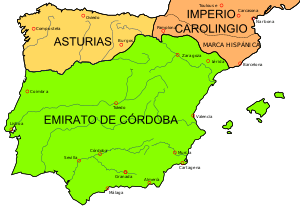Battle of las Babias
| Battle of las Babias | |||||||
|---|---|---|---|---|---|---|---|
| Part of Razias of Hirsham I the Reconquista | |||||||
 A map of the Iberian Peninsula around the time of the conflict. | |||||||
| |||||||
| Belligerents | |||||||
|
| Emirate of Córdoba | ||||||
| Commanders and leaders | |||||||
|
|
Hisham I of Córdoba Abd al-Karim ibn Abd al-Wahid ibn Mugit Farach ibn Kinanah | ||||||
| Strength | |||||||
| Unknown | 10,000 | ||||||
| Casualties and losses | |||||||
| Unknown | Unknown | ||||||
Part of a series on the |
|---|
| History of Spain |
.svg.png) |
| Timeline |
|
|
The Battle of las Babias occurred in the year 795 when the Emir of Cordoba, Hisham I of Córdoba sought to avenge his previous military incursions in 794 against the Kingdom of Asturias under the command of the brothers Abd al-Karim ibn Abd al-Walid ibn Mugaith and Abd al-Malik ibn Abd al-Walid ibn Mugaith. The previous battles resulted in devastating losses for the Emirate, most importantly at the Battle of Lutos where one of the Emir's generals was killed in action.[1] The battle resulted in a Córdoban victory.
Background
The Córdoban Emir, Hirsham I sought revenge for the defeat of his army in 794 at the Battle of Lutos in which the Córdoban general Abd al-Malik ibn Abd al-Walid ibn Mugaith was killed in action.[note 1] To achieve this end, he sent his brother, Abd al-Karim ibn Abd al-Walid ibn Mugaith at the head of an army of 10,000 men under arms against the Kingdom of Asturias.
The Emir also organized another army which marched against the Kingdom of Galicia to divert any potential conversion of Christian forces on his brother's army in Asturias. This second column entered Galicia and proceeded to lay waste to the land. Upon its withdrawal, it came into a separate engagement with Galician and Asturian forces and was routed. In this action, the Muslims suffered heavy losses and forces captured, but managed to escape eventually.
King Alfonso II of Asturias, who had reinforced his army with local machus[note 2] made his camp near Astorga.[2] The area had been a base of operations for Muslim attacks against Asturias via Puerto de Mesa.[3] From there, the Asturian king sent the local inhabitants into the surrounding mountains and waited for the Córdoban forces to engage him. The location was favorable in that his line of retreat was guaranteed via Puerto de Ventana.
Battle
Abd al-Karim sent his vanguard of 4,000 men against Alfonso II's main force under the command of Farach ibn Kinanah, the commander of the Sidoniyya Division. Abd al-Karim ibn Abd al-Walid ibn Mugaith himself advanced shortly afterwards with the rearguard and reserves and their combined forces managed to successfully rout the Asturians. As planned, the Asturians retreated via Puerto de Ventana while fighting a rearguard action against pursuing Córdoban cavalry.
Aftermath
Abd al-Karim ibn Abd al-Walid ibn Mugaith and Farach ibn Kinanah proceeded to then defeat the forces of the Kingdom of Asturias at the Battle of Río Quirós, again at the Battle of Río Nalón, and culminating in the capture of Oviedo.[4][note 3] With the onset of winter, the Córdoban forces retreated back to their lands without dealing a finishing blow to the Kingdom of Asturias. The Asturian king Alfonso II was able to escape with his host.
The death of Hisham I of Córdoba and the subsequent disputes between his heirs ensured that the Kingdom of Asturias could recover from the series of defeats in the course of a few years. The time allowed for Alfonso II of Asturias to cement an alliance with Charlemagne, King of the Franks.[5]
Notes
References
- ↑ Roger Collins, Caliphs and Kings: Spain, 796-1031, 65.
- ↑ "Abd al-Karim". Enciclopedia de Oviedo (in Spanish). Retrieved February 27, 2014.
- ↑ Suárez Fernández, Luis (1976). Historia de España Antigua y media (in Spanish). Ediciones Rialp. p. 170. ISBN 978-84-321-1882-1. Retrieved February 27, 2014.
- ↑ Menéndez Pidal, Ramón (1956). Historia de España. Tomo VI. Madrid: Espasa-Calpe, pp. 45.
- ↑ Junta de Castilla y León. "La consolidación del emirato". Artehistoria (in Spanish). Retrieved February 27, 2014.
Bibliography
- Cabal, Constantino, Benito Ruano, Eloy., pr.:Alfonso II El Casto, fundador de Oviedo. Grupo Editorial Asturiano. 1991. ISBN 84-404-8512-3
- Asturianos universales 7 : Alfonso II, el Casto, Félix de Aramburu y Zuloaga, Alfonso I, José Posada Herrera, Ramón Menéndez Pidal. Ediciones Páramo, S.A. 1996. ISBN 84-87253-26-1
- Códice testamento Alfonso II el Casto y estudio de la obra. Ediciones Madú 2 v ISBN 84-95998-72-6
- David Levering Lewis (2009) [2008]. El Crisol de Dios. El Islam y el nacimiento de Europa (570-1215). Editorial Paidós, Barcelona, ISBN 978-84-493-2233-4.
- Gebhardt, Víctor (1864). Historia general de España y de sus Indias desde los tiempos más remotos hasta nuestros días: tomada de las principales historias, crónicas y anales que acerca de los sucesos ocurridos en nuestra patria se han escrito (in Spanish). Madrid: Librería Española. Retrieved February 27, 2014.
Tomo II
- Torrente, Mariano. Geografía universal física, política é histórica (in Spanish). Madrid: Imprenta de Don Miguel de Burgos. Retrieved February 27, 2014.
Tomo I
External links
Coordinates: 43°20′00″N 6°25′00″W / 43.3333°N 6.4167°W